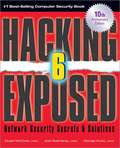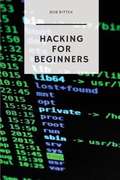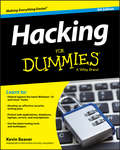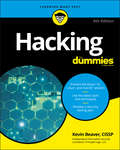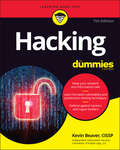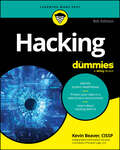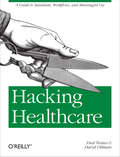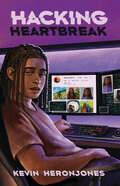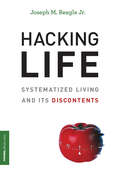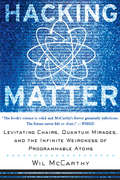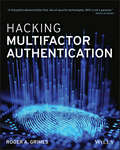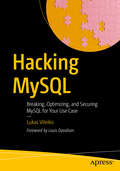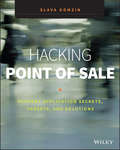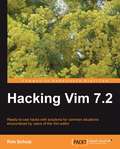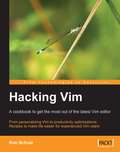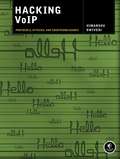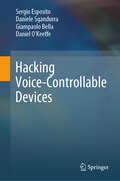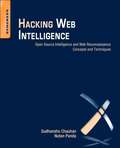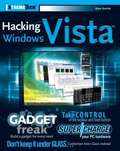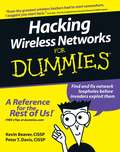- Table View
- List View
Hacking Exposed: Network Security Secrets and Solutions (6th Edition)
by Stuart Mcclure Joel Scambray George KurtzMeet the formidable demands of security in today's hyperconnected world with expert guidance from the world-renowned Hacking Exposed team. Following the time-tested "attack-countermeasure" philosophy, this 10th anniversary edition has been fully overhauled to cover the latest insidious weapons in the hacker's extensive arsenal. New and updated material: New chapter on hacking hardware, including lock bumping, access card cloning, RFID hacks, USB U3 exploits, and Bluetooth device hijacking Updated Windows attacks and countermeasures, including new Vista and Server 2008 vulnerabilities and Metasploit exploits The latest UNIX Trojan and rootkit techniques and dangling pointer and input validation exploits New wireless and RFID security tools, including multilayered encryption and gateways All-new tracerouting and eavesdropping techniques used to target network hardware and Cisco devices Updated DoS, man-in-the-middle, DNS poisoning, and buffer overflow coverage VPN and VoIP exploits, including Google and TFTP tricks, SIP flooding, and IPsec hacking Fully updated chapters on hacking the Internet user, web hacking, and securing code
Hacking For Beginners: The Ultimate Guide To Becoming A Hacker
by Bob BittexAre you interested in hacking? Always been curious about hacking but never did anything? Simply browsing and looking for a new awesome computer-related hobby?Then this book is for you!This book will teach the basics and details of hacking as well as the different types of hacking. The book is targeted towards beginners who have never hacked before and are not familiar with any of the terms in hacking. The book includes practical examples with pictures and exercises that can be done online. I am Bob Bittex - ethical hacker, computer science teacher, security researcher and analyst and I would like to invite you to the world of hacking. This book includes: An introduction to hacking and hacking terms Potential security threats to computer systems What is a security threat Skills required to become an ethical hacker Programming languages for hacking Other necessary skills for hackers Hacking tools Social engineering Cryptography, cryptanalysis, cryptology Password cracking techniques and tools Worms, viruses and trojans ARP poisoning Wireshark - network and password sniffing Hacking wi-fi (wireless) networks Dos (Denial of Service) Attacks, ping of death, DDOS Hacking a web server Hacking websites SQL injections Hacking Linux OS Most common web security vulnerabilities Are you ready to learn about hacking?Scroll up, hit that buy button!
Hacking For Dummies
by Kevin BeaverUpdated for Windows 8 and the latest version of LinuxThe best way to stay safe online is to stop hackers before they attack - first, by understanding their thinking and second, by ethically hacking your own site to measure the effectiveness of your security. This practical, top-selling guide will help you do both. Fully updated for Windows 8 and the latest version of Linux, Hacking For Dummies, 4th Edition explores the malicious hacker's mindset and helps you develop an ethical hacking plan (also known as penetration testing) using the newest tools and techniques. More timely than ever, this must-have book covers the very latest threats, including web app hacks, database hacks, VoIP hacks, and hacking of mobile devices.Guides you through the techniques and tools you need to stop hackers before they hack youCompletely updated to examine the latest hacks to Windows 8 and the newest version of LinuxExplores the malicious hackers's mindset so that you can counteract or avoid attacks completelySuggests ways to report vulnerabilities to upper management, manage security changes, and put anti-hacking policies and procedures in placeIf you're responsible for security or penetration testing in your organization, or want to beef up your current system through ethical hacking, make sure you get Hacking For Dummies, 4th Edition.
Hacking For Dummies
by Kevin BeaverStop hackers before they hack you! In order to outsmart a would-be hacker, you need to get into the hacker’s mindset. And with this book, thinking like a bad guy has never been easier. In Hacking For Dummies, expert author Kevin Beaver shares his knowledge on penetration testing, vulnerability assessments, security best practices, and every aspect of ethical hacking that is essential in order to stop a hacker in their tracks. Whether you’re worried about your laptop, smartphone, or desktop computer being compromised, this no-nonsense book helps you learn how to recognize the vulnerabilities in your systems so you can safeguard them more diligently—with confidence and ease. Get up to speed on Windows 10 hacks Learn about the latest mobile computing hacks Get free testing tools Find out about new system updates and improvements There’s no such thing as being too safe—and this resourceful guide helps ensure you’re protected.
Hacking For Dummies
by Kevin BeaverLearn to think like a hacker to secure your own systems and data Your smartphone, laptop, and desktop computer are more important to your life and business than ever before. On top of making your life easier and more productive, they hold sensitive information that should remain private. Luckily for all of us, anyone can learn powerful data privacy and security techniques to keep the bad guys on the outside where they belong. Hacking For Dummies takes you on an easy-to-follow cybersecurity voyage that will teach you the essentials of vulnerability and penetration testing so that you can find the holes in your network before the bad guys exploit them. You will learn to secure your Wi-Fi networks, lock down your latest Windows 11 installation, understand the security implications of remote work, and much more. You’ll find out how to: Stay on top of the latest security weaknesses that could affect your business’s security setup Use freely available testing tools to “penetration test” your network’s security Use ongoing security checkups to continually ensure that your data is safe from hackers Perfect for small business owners, IT and security professionals, and employees who work remotely, Hacking For Dummies is a must-have resource for anyone who wants to keep their data safe.
Hacking For Dummies
by Kevin BeaverThink like a hacker to protect your sensitive information To safeguard your private data from prying eyes, it helps to understand how hackers do what they do. Hacking For Dummies gives you the tools you need to step into a hacker's shoes and discover the best strategies to secure your data. You won't learn how to steal your neighbors' Wi-Fi, but you will gain the skills to keep nosy hackers out of your systems and applications. With clear, jargon-free explanations, you'll learn to recognize cyberthreats and keep your information safe. This updated edition includes new content on AI, the Internet of Things (IoT), and the security implications of hybrid work. Understand the tools hackers use to steal sensitive data from individuals and businesses Discover methods of protecting your information—including improving your security, recognizing phishing scams, and more Assess your current network and cloud configurations from a hacker's perspective using proven vulnerability and penetration testing techniques Defend against AI-generated scams, lost devices, and other common threats Hacking For Dummies is for anyone looking to protect their devices from hacking—at home, at the office, or anywhere in-between.
Hacking Healthcare: A Guide to Standards, Workflows, and Meaningful Use
by Fred Trotter David UhlmanReady to take your IT skills to the healthcare industry? This concise book provides a candid assessment of the US healthcare system as it ramps up its use of electronic health records (EHRs) and other forms of IT to comply with the government’s Meaningful Use requirements. It’s a tremendous opportunity for tens of thousands of IT professionals, but it’s also a huge challenge: the program requires a complete makeover of archaic records systems, workflows, and other practices now in place.This book points out how hospitals and doctors’ offices differ from other organizations that use IT, and explains what’s necessary to bridge the gap between clinicians and IT staff.Get an overview of EHRs and the differences among medical settingsLearn the variety of ways institutions deal with patients and medical staff, and how workflows varyDiscover healthcare’s dependence on paper records, and the problems involved in migrating them to digital documentsUnderstand how providers charge for care, and how they get paidExplore how patients can use EHRs to participate in their own careExamine healthcare’s most pressing problem—avoidable errors—and how EHRs can both help and exacerbate it
Hacking Healthcare: How AI and the Intelligence Revolution Will Reboot an Ailing System
by Tom LawryIn this original work, Tom Lawry takes readers on a journey of understanding what we learned from fighting a global pandemic and how to apply these learnings to solve healthcare's other big challenges. This book is about empowering clinicians and consumers alike to take control of what is important to them by harnessing the power of AI and the Intelligent Health Revolution to create a sustainable system that focuses on keeping all citizens healthy while caring for them when they are not.
Hacking Heartbreak
by Kevin heronJonesAfter hacking the social media accounts of his crush, Baron is in a race against the clock to fix the mess he made and save her from serious consequences. Baron is a computer whiz with a passion for hacking, and when the girl of his dreams starts taking an interest in him, he all but short circuits. Keyanna sees their dates as more casual than the love-struck Baron, but everything seems to be going well. When he sees her on a date with another guy, Baron hacks her school and social media accounts, angry and hurt. As jealousy fades and reality sets in, Baron realizes the seriousness of his action. Knowing regret will never be enough, Baron races against the clock to fix his mess. Kevin heronJones’s latest is another realistic, authentic depiction of the life of a Black youth in Canada. Set in Brampton, Hacking Heartbreak is a story about the intensity of first love and learning to live with the consequences of your actions.
Hacking ISIS: How to Destroy the Cyber Jihad
by Malcolm Nance Christopher SampsonThis book is written by two of the leading terrorist experts in the world - Malcolm Nance, NBC News/MSNBC terrorism analyst and Christopher Sampson, cyber-terrorist expert. Malcolm Nance is a 35 year practitioner in Middle East Special Operations and terrorism intelligence activities. Chris Sampson is the terrorism media and cyber warfare expert for the Terror Asymmetric Project and has spent 15 years collecting and exploiting terrorism media. For two years, their Terror Asymmetrics Project has been attacking and exploiting intelligence found on ISIS Dark Web operations.Hacking ISIS will explain and illustrate in graphic detail how ISIS produces religious cultism, recruits vulnerable young people of all religions and nationalities and disseminates their brutal social media to the world.More, the book will map out the cyberspace level tactics on how ISIS spreads its terrifying content, how it distributes tens of thousands of pieces of propaganda daily and is winning the battle in Cyberspace and how to stop it in its tracks.Hacking ISIS is uniquely positioned to give an insider’s view into how this group spreads its ideology and brainwashes tens of thousands of followers to join the cult that is the Islamic State and how average computer users can engage in the removal of ISIS from the internet.
Hacking Kubernetes: Threat-Driven Analysis and Defense
by Andrew Martin Michael HausenblasWant to run your Kubernetes workloads safely and securely? This practical book provides a threat-based guide to Kubernetes security. Each chapter examines a particular component's architecture and potential default settings and then reviews existing high-profile attacks and historical Common Vulnerabilities and Exposures (CVEs). Authors Andrew Martin and Michael Hausenblas share best-practice configuration to help you harden clusters from possible angles of attack.This book begins with a vanilla Kubernetes installation with built-in defaults. You'll examine an abstract threat model of a distributed system running arbitrary workloads, and then progress to a detailed assessment of each component of a secure Kubernetes system.Understand where your Kubernetes system is vulnerable with threat modelling techniquesFocus on pods, from configurations to attacks and defensesSecure your cluster and workload trafficDefine and enforce policy with RBAC, OPA, and KyvernoDive deep into sandboxing and isolation techniquesLearn how to detect and mitigate supply chain attacksExplore filesystems, volumes, and sensitive information at restDiscover what can go wrong when running multitenant workloads in a clusterLearn what you can do if someone breaks in despite you having controls in place
Hacking Life: Systematized Living and Its Discontents (Strong Ideas)
by Joseph M. ReagleIn an effort to keep up with a world of too much, life hackers sometimes risk going too far.Life hackers track and analyze the food they eat, the hours they sleep, the money they spend, and how they're feeling on any given day. They share tips on the most efficient ways to tie shoelaces and load the dishwasher; they employ a tomato-shaped kitchen timer as a time-management tool.They see everything as a system composed of parts that can be decomposed and recomposed, with algorithmic rules that can be understood, optimized, and subverted. In Hacking Life, Joseph Reagle examines these attempts to systematize living and finds that they are the latest in a long series of self-improvement methods. Life hacking, he writes, is self-help for the digital age's creative class.Reagle chronicles the history of life hacking, from Benjamin Franklin's Poor Richard's Almanack through Stephen Covey's 7 Habits of Highly Effective People and Timothy Ferriss's The 4-Hour Workweek. He describes personal outsourcing, polyphasic sleep, the quantified self movement, and hacks for pickup artists. Life hacks can be useful, useless, and sometimes harmful (for example, if you treat others as cogs in your machine). Life hacks have strengths and weaknesses, which are sometimes like two sides of a coin: being efficient is not the same thing as being effective; being precious about minimalism does not mean you are living life unfettered; and compulsively checking your vital signs is its own sort of illness. With Hacking Life, Reagle sheds light on a question even non-hackers ponder: what does it mean to live a good life in the new millennium?
Hacking Matter: Levitating Chairs, Quantum Mirages, and the Infinite Weirdness of Programmable Atoms
by Wil MccarthyProgrammable matter is probably not the next technological revolution, nor even perhaps the one after that. But it's coming, and when it does, it will change our lives as much as any invention ever has. Imagine being able to program matter itself-to change it, with the click of a cursor, from hard to soft, from paper to stone, from fluorescent to super-reflective to invisible. Supported by organizations ranging from Levi Strauss and IBM to the Defense Department, solid-state physicists in renowned laboratories are working to make it a reality. In this dazzling investigation, Wil McCarthy visits the laboratories and talks with the researchers who are developing this extraordinary technology, describes how they are learning to control it, and tells us where all this will lead. The possibilities are truly astonishing.
Hacking Multifactor Authentication
by Roger A. GrimesProtect your organization from scandalously easy-to-hack MFA security “solutions” Multi-Factor Authentication (MFA) is spreading like wildfire across digital environments. However, hundreds of millions of dollars have been stolen from MFA-protected online accounts. How? Most people who use multifactor authentication (MFA) have been told that it is far less hackable than other types of authentication, or even that it is unhackable. You might be shocked to learn that all MFA solutions are actually easy to hack. That’s right: there is no perfectly safe MFA solution. In fact, most can be hacked at least five different ways. Hacking Multifactor Authentication will show you how MFA works behind the scenes and how poorly linked multi-step authentication steps allows MFA to be hacked and compromised. This book covers over two dozen ways that various MFA solutions can be hacked, including the methods (and defenses) common to all MFA solutions. You’ll learn about the various types of MFA solutions, their strengthens and weaknesses, and how to pick the best, most defensible MFA solution for your (or your customers') needs. Finally, this book reveals a simple method for quickly evaluating your existing MFA solutions. If using or developing a secure MFA solution is important to you, you need this book. Learn how different types of multifactor authentication work behind the scenes See how easy it is to hack MFA security solutions—no matter how secure they seem Identify the strengths and weaknesses in your (or your customers’) existing MFA security and how to mitigate Author Roger Grimes is an internationally known security expert whose work on hacking MFA has generated significant buzz in the security world. Read this book to learn what decisions and preparations your organization needs to take to prevent losses from MFA hacking.
Hacking MySQL: Breaking, Optimizing, and Securing MySQL for Your Use Case
by Lukas VileikisYour MySQL instances are probably broken. Many developers face slow-running queries, issues related to database architecture, replication, or database security—and that’s only the beginning. This book will deliver answers to your most pressing MySQL database questions related to performance, availability, or security by uncovering what causes databases to break in the first place. At its core, this book provides you with the knowledge necessary for you to break your database instances so you can better optimize it for performance and secure it from data breaches. In other words, you’ll discover the sorts of actions, minor and major, that degrade databases so you can fix and ultimately preempt them. MySQL sometimes acts according to its own rules, and this book will help you keep it working on your terms. At the same time, you will learn to optimize your backup and recovery procedures, determine when and which data to index to achieve maximum performance, and choose the best MySQL configurations, among other essential skills. Most MySQL books focus exclusively on optimization, but this book argues that it’s just as important to pay attention to the ways databases break. Indeed, after reading this book, you will be able to safely break your database instances to expose and overcome the nuanced issues that affect performance, availability, and security. What You Will Learn Know the basics of MySQL and the storage engines innoDB and MyISAM Spot the ways you are harming your database’s performance, availability and security without even realizing it Fix minor bugs and issues that have surprisingly serious impact Optimize schema, data types, queries, indexes, and partitions to head off issues Understand key MySQL security strategies Who This Book Is For Database administrators, web developers, systems administrators, and security professionals with an intermediary knowledge of database management systems and building applications in MySQL
Hacking Point of Sale
by Slava GomzinMust-have guide for professionals responsible for securing credit and debit card transactions As recent breaches like Target and Neiman Marcus show, payment card information is involved in more security breaches than any other data type. In too many places, sensitive card data is simply not protected adequately. Hacking Point of Sale is a compelling book that tackles this enormous problem head-on. Exploring all aspects of the problem in detail - from how attacks are structured to the structure of magnetic strips to point-to-point encryption, and more - it's packed with practical recommendations. This terrific resource goes beyond standard PCI compliance guides to offer real solutions on how to achieve better security at the point of sale. A unique book on credit and debit card security, with an emphasis on point-to-point encryption of payment transactions (P2PE) from standards to design to application Explores all groups of security standards applicable to payment applications, including PCI, FIPS, ANSI, EMV, and ISO Explains how protected areas are hacked and how hackers spot vulnerabilities Proposes defensive maneuvers, such as introducing cryptography to payment applications and better securing application code Hacking Point of Sale: Payment Application Secrets, Threats, and Solutions is essential reading for security providers, software architects, consultants, and other professionals charged with addressing this serious problem.
Hacking The Cyber Threat: A Cybersecurity Primer For Law-enforcement Leaders And Executives
by Pedro CorderoToday’s greatest strategic cybersecurity challenge is the lack of cyber savvy leaders and executives in both the private and public sector. As a leader or executive, how cyber savvy are you? Is your leadership team or mid-management team cyber savvy? Does your strategic leadership on cybersecurity depend on the CIO, CISO, or IT Director to explain all the cybersecurity issues impacting your organization and you only understand a minimal aspect of this threat?
Hacking Vim 7.2
by Kim SchulzThis book is a tutorial packed with ready-to-use hacks that give solutions for common problems faced by Vim users in their everyday life. Every chapter covers a set of recipes, each of which follows a systematic approach with a self-contained description of the task it covers, how to use it, and what you gain by using it. The minimum version of Vim required for each hack is clearly indicated. If you are a Vim user who wants to get more out of this legendary text editor, this book is for you. It focuses on making life easier for intermediate to experienced Vim users.
Hacking Vim: A Cookbook to get the Most out of the Latest Vim Editor
by Kim SchulzThis is a cookbook packed with ready-to-use hacks that give solutions for some of the commonest problems users of the Vim editor encounter during their daily use. Each recipe follows a systematic approach with a self-contained description of the task it covers, how to use it, and what you gain by using it. The reader can read any of the hacks in this book without having to read any of the other hacks "where necessary they include cross-references to other relevant hacks. The minimum version of Vim required for each hack is clearly indicated. This is a cookbook packed with ready-to-use hacks that give solutions for some of the commonest problems users of the Vim editor encounter during their daily use. Each recipe follows a systematic approach with a self-contained description of the task it covers, how to use it, and what you gain by using it. The reader can read any of the hacks in this book without having to read any of the other hacks "where necessary they include cross-references to other relevant hacks. The minimum version of Vim required for each hack is clearly indicated.
Hacking VoIP: Protocols, Attacks, and Countermeasures (No Starch Press Ser.)
by Himanshu Dwivedi<P>Voice over Internet Protocol (VoIP) networks have freed users from the tyranny of big telecom, allowing people to make phone calls over the Internet at very low or no cost. But while VoIP is easy and cheap, it's notoriously lacking in security. With minimal effort, hackers can eavesdrop on conversations, disrupt phone calls, change caller IDs, insert unwanted audio into existing phone calls, and access sensitive information. <P>Hacking VoIP takes a dual approach to VoIP security, explaining its many security holes to hackers and administrators. If you're serious about security, and you either use or administer VoIP, you should know where VoIP's biggest weaknesses lie and how to shore up your security. And if your intellectual curiosity is leading you to explore the boundaries of VoIP, Hacking VoIP is your map and guidebook. <P>Hacking VoIP will introduce you to every aspect of VoIP security, both in home and enterprise implementations. You'll learn about popular security assessment tools, the inherent vulnerabilities of common hardware and software packages, and how to: <br>–Identify and defend against VoIP security attacks such as eavesdropping, audio injection, caller ID spoofing, and VoIP phishing <br>–Audit VoIP network security <br>–Assess the security of enterprise-level VoIP networks such as Cisco, Avaya, and Asterisk, and home VoIP solutions like Yahoo! and Vonage <br>–Use common VoIP protocols like H.323, SIP, and RTP as well as unique protocols like IAX <br>–Identify the many vulnerabilities in any VoIP network <P>Whether you’re setting up and defending your VoIP network against attacks or just having sick fun testing the limits of VoIP networks, Hacking VoIP is your go-to source for every aspect of VoIP security and defense.
Hacking Voice-Controllable Devices
by Sergio Esposito Giampaolo Bella Daniele Sgandurra Daniel O’KeeffeVoice-controllable devices allow hands-free interactions, offering a modern user experience and helping impaired users. However, the voice channel that enables this interaction is also one of their main weaknesses. Higher usability often comes with higher security and privacy risks. As Voice-Controllable Devices are no exception to this, a plethora of new attacks have been carried out against them in recent years. In this book, several attacks are analysed against the voice channel available in the literature; it then devises a bespoke kill chain to facilitate the classification of attack steps and future research. Additionally, the work analyses the design of the notorious Alexa vs Alexa attack, which turned Echo Dot devices against themselves in 2022. Finally, the present volume explores measures against all these attacks and raise important questions about their suitability for user needs. Topics and features: Discusses timely security and privacy challenges in IoT devices, with an emphasis on voice-controllable devices Provides a framework for assessing and studying attacks against the voice channel Addresses practical attacks successfully carried out against real devices, showing that an impactful attack need not be complex Explores advanced safeguards from a new perspective, questioning whether research is proceeding in the right direction This powerful volume—containing tips, tricks, and techniques used by ethical hackers to breach the voice channel—serves as the perfect guide for researchers conducting security and privacy research on IoT. It also provides food for thought for graduate students and enthusiasts of these subjects who do not shy away from the mathematics behind the world of machine learning.
Hacking Web Intelligence: Open Source Intelligence and Web Reconnaissance Concepts and Techniques
by Sudhanshu Chauhan Nutan Kumar PandaOpen source intelligence (OSINT) and web reconnaissance are rich topics for infosec professionals looking for the best ways to sift through the abundance of information widely available online. In many cases, the first stage of any security assessment-that is, reconnaissance-is not given enough attention by security professionals, hackers, and penetration testers. Often, the information openly present is as critical as the confidential data. Hacking Web Intelligence shows you how to dig into the Web and uncover the information many don't even know exists. The book takes a holistic approach that is not only about using tools to find information online but also how to link all the information and transform it into presentable and actionable intelligence. You will also learn how to secure your information online to prevent it being discovered by these reconnaissance methods. Hacking Web Intelligence is an in-depth technical reference covering the methods and techniques you need to unearth open source information from the Internet and utilize it for the purpose of targeted attack during a security assessment. This book will introduce you to many new and leading-edge reconnaissance, information gathering, and open source intelligence methods and techniques, including metadata extraction tools, advanced search engines, advanced browsers, power searching methods, online anonymity tools such as TOR and i2p, OSINT tools such as Maltego, Shodan, Creepy, SearchDiggity, Recon-ng, Social Network Analysis (SNA), Darkweb/Deepweb, data visualization, and much more. Provides a holistic approach to OSINT and Web recon, showing you how to fit all the data together into actionable intelligence Focuses on hands-on tools such as TOR, i2p, Maltego, Shodan, Creepy, SearchDiggity, Recon-ng, FOCA, EXIF, Metagoofil, MAT, and many more Covers key technical topics such as metadata searching, advanced browsers and power searching, online anonymity, Darkweb / Deepweb, Social Network Analysis (SNA), and how to manage, analyze, and visualize the data you gather Includes hands-on technical examples and case studies, as well as a Python chapter that shows you how to create your own information-gathering tools and modify existing APIs
Hacking Windows Vista
by Steve SinchakVista is the most radical revamping of Windows since 1995. However, along with all the fantastic improvements, there are a couple of things that likely drive you up the wall. Don't worry, though-just join forces with author Steve Sinchak and you'll end up feeling as though Microsoft designed Vista just for you! He shows you how to tweak logon screen settings, build custom Sidebar gadgets, personalize Aero Glass with themes and visual styles, turn your PC into an HDTV media center, fine-tune your firewall, and more.
Hacking Wireless Networks For Dummies
by Kevin Beaver Devin K. Akin Peter T. DavisBecome a cyber-hero - know the common wireless weaknesses"Reading a book like this one is a worthy endeavor toward becoming an experienced wireless security professional."--Devin Akin - CTO, The Certified Wireless Network Professional (CWNP) ProgramWireless networks are so convenient - not only for you, but also for those nefarious types who'd like to invade them. The only way to know if your system can be penetrated is to simulate an attack. This book shows you how, along with how to strengthen any weak spots you find in your network's armor.Discover how to:Perform ethical hacks without compromising a systemCombat denial of service and WEP attacksUnderstand how invaders thinkRecognize the effects of different hacksProtect against war drivers and rogue devices
Hacking With Kali Linux: A Step By Step Guide For You To Learn The Basics Of Cybersecurity And Hacking (Cybersecurity And Hacking)
by Ramon NastaseThis book will show you how Hacking works. You will have a chance to understand how attackers gain access to your systems and steal information. Also, you will learn what you need to do in order to protect yourself from all kind of hacking techniques.
